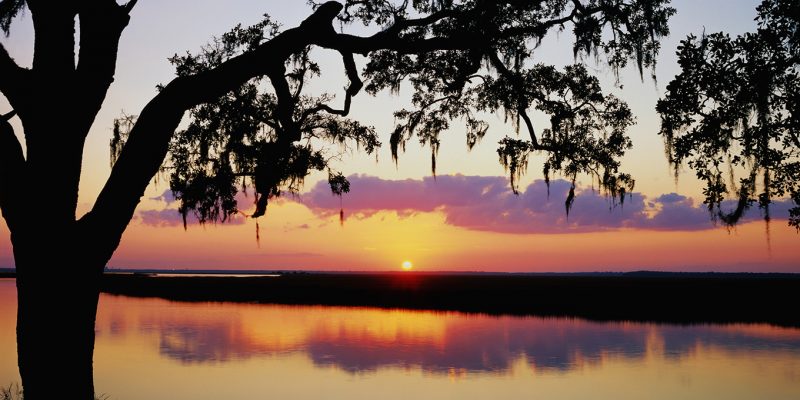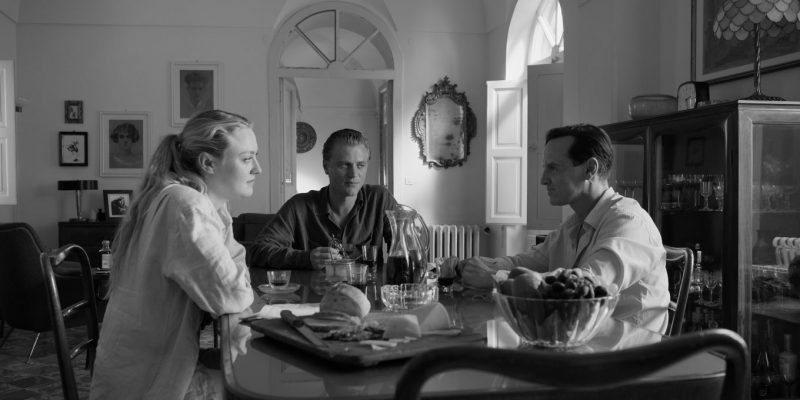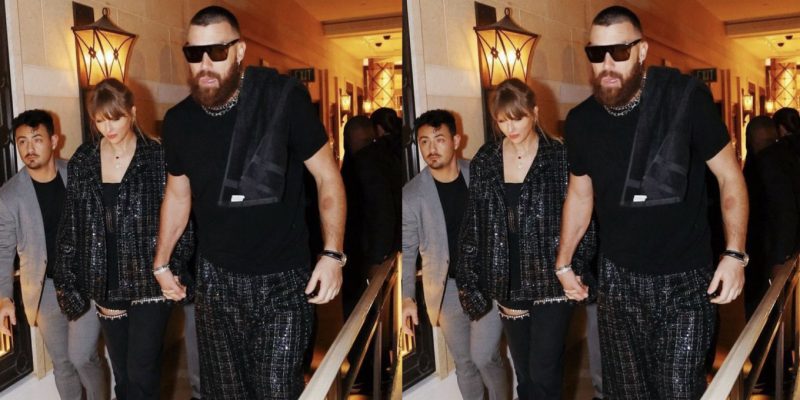Culture
Winnie Harlow Is Entering Her Next Act
As she celebrates a decade at the top of her industry, Canadian supermodel, entrepreneur and aspiring actor Winnie Harlow steps into a new era.
by : Sumiko Wilson- Nov 17th, 2023
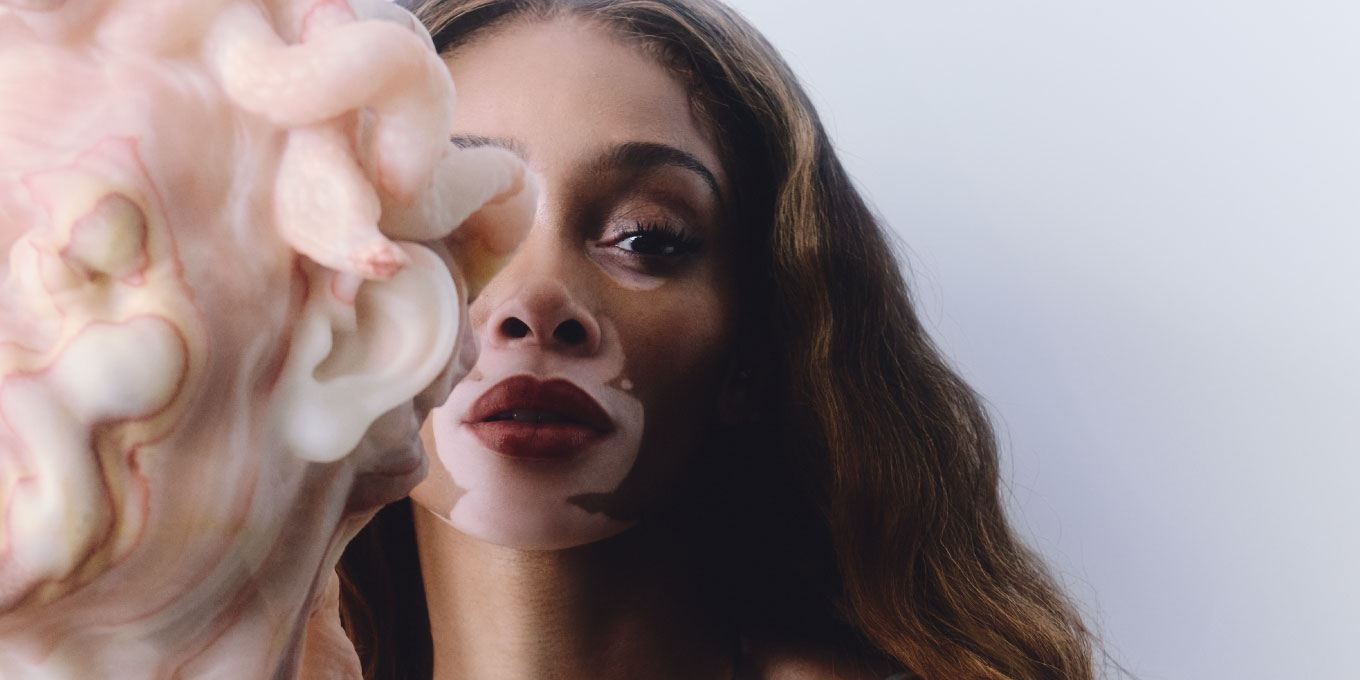
Carlos and Alyse
Winnie Harlow doesn’t set New Year’s resolutions. It’s a practice she has intentionally abstained from. At the end of each year, she’d always notice that her aspirations paled in comparison to what she actually achieved. “It was almost as if some of the things I got I couldn’t even have dreamt of,” she says.
Since making her debut as the world’s first model with the skin condition vitiligo 10 years ago, she has made a habit of exceeding expectations. In fact, she didn’t initially plan on being a model at all. But it’s not by happenstance—when she struts into Bistrot Leo in New York’s SoHo neighbourhood on a balmy October afternoon, it’s impossible to see her as anything else. Arriving sans entourage and without a shred of makeup, she wields an unspoken power that commands attention. Her arrival brings forth an inaudible whoosh as diners’ heads swivel to clock her presence as she settles onto a banquette.
“I don’t know if the idea of being a model actually appealed to me prior to [becoming one],” she says. “I wanted to be a journalist.” Before Chantelle Brown-Young, the Mississauga, Ont., native who worked in retail, became Winnie Harlow, the barrier-breaking icon, the industry didn’t consider her a contender. Over the years, she has often told the story of how a modelling agent dismissed her by saying that if she wanted to be part of the fashion world, she should instead try to be a makeup artist.
 Carlos + Alyse
Carlos + AlyseDress (Binya at Ssense), corset (Knwls at Ssense) and necklace (Tiffany & Co.)
Harlow’s moniker—a combination of homages to Winnie the Pooh and Jean Harlow, the emblematic 1930s leading lady—originated as a username on Facebook when she was a teen. And since it was her social-media handle, she has technically gone by “Winnie” since the end of high school. Personally, I can recall when her alias began appearing on my own Facebook timeline long before she was making headlines. Having grown up attending the same church as Harlow and being just a few years younger than her, I can vividly remember seeing her as a tween and then as a teenager. When we meet again for this interview in New York City all these years later, she doesn’t fully register the connection. Then, in an instant, she does. “You were so cute,” she recalls. “You always had cute cheeks.”
Decades ago, we were part of the same small Pentecostal congregation in Malton, Ont. Sunday after Sunday, I’d see her in a pew with her younger sister and her mom. When the preachers were long-winded, as they often were, I’d notice her retreating to the church’s carpeted staircase with friends, giggling and taking photos. Even when I was in elementary school and she was a preteen, it was evident that she exuded an indelible sense of self-assurance. The last time I saw her, more than 12 years ago, my mother and I were on an eastbound subway and caught her as she was leaving the Toronto Eaton Centre excitedly toting an Aritzia bag. On the train, she shared that she had purchased a winter jacket. Just a few years later, she was on an ad at that same station.
 Carlos + Alyse
Carlos + AlyseSleeping Hermaphrodite (2008-2017) By Barry X Ball, Sculpture, translucent pink Iranian onyx; Base (47 X 173 X 91 CM), Greek thassos marble and stainless steel. Dress (Gucci), cuff bracelet (Elsa Peretti at Tiffany & Co.) and rings (Tiffany & Co.)
When we were children, in the era of the homogenizing “Prada effect” and “Nothing tastes as good as skinny feels,” my own imagination couldn’t conceive of a modelling industry that held up the girl I knew from church as one of its most recognizable faces. As years passed, I admired her ascent from afar: She grew an Instagram following, was cast on America’s Next Top Model and then courted the attention of famed photographer Nick Knight, who shot her for a Diesel campaign that altered her trajectory. Since then, whether she’s gracing runways for Christian Cowan or red carpets for Vogue World, designing athleisure collections for Puma, posing with Kim Jones and Naomi Campbell at Fashion Week or taking part in what was once considered “Fashion’s Sexiest Night,” the Victoria’s Secret Fashion Show (most recently, she returned to the brand’s runway in the globe-trotting showcase dubbed “The Tour”), Harlow’s very presence has been viewed as a harbinger of a more inclusive industry. And her impact is unequivocal. As part of a class of models believed to be the “super” resurgence (with peers like Kendall Jenner and the Hadid sisters), her celebrity is imbued with a distinct weight that sets her apart from some of her contemporaries. It means something. It says something. It creates opportunities and dismantles the exclusionary systems that have existed for longer than she’s been alive.
After years of working with Harlow, designer Jeremy Scott believes that her position in the industry will encourage people to expand their notion of beauty. “Nothing is more beautiful than diversity,” he says. Once Scott saw Knight’s first photos of Harlow, he knew that he wanted to work with her. When they finally met in February 2018 at a New York Fashion Week afterparty for one of his shows, they instantly clicked. “She was wearing a look from my collection and was so radiantly beautiful, and she oozed warmth and kindness to boot,” the former Moschino creative director recalls. Since then, Harlow has walked in Moschino shows, and she starred in a lookbook for the brand’s 2021 pre-fall collection. “I’ve championed unique beauties since the start of my career— with Devon Aoki, then Sophie Dahl—and Winnie is part of this lineage [of models who] can break the mould of what the current beauty standard is and expand it for a new generation.” Together, the pair coached emerging talent when they appeared as judges on the second season of Amazon’s fashion competition series Making the Cut.
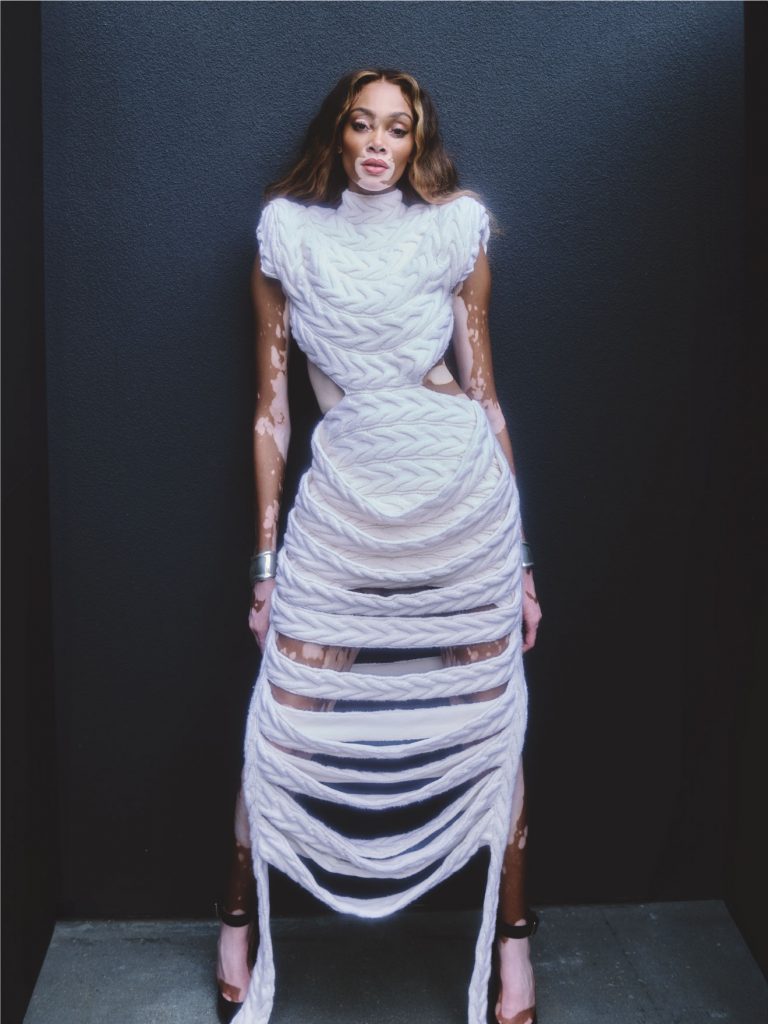 Carlos + Alyse
Carlos + AlyseDress and shoes (Alexander McQueen) and cuff bracelets (Elsa Peretti at Tiffany & Co.)
“Winnie’s undeniable beauty coupled with her visible vitiligo makes her such a modern-day beauty icon,” raves Scott. “[She has] that rare, special, unique combination [along] with [an] out-of-this-world personality, and she really knows how to model.” And this past August, the United Nations Association in Canada also recognized Harlow’s impact on the industry and announced that she would receive the 2023 Global Citizen Award, a prize that honours Canadian change makers leading the way. In a release, the UN praised Harlow for “shattering norms” in fashion and advocating for diversity.
While Harlow is proud of what her career has come to represent, the idea of being a role model was initially a lot to manage. “I’m not here to raise anyone’s kids—I’m here as a child who turned into a teenager and then turned into an adult in front of people,” she tells me. “That doesn’t mean that I’m not supposed to make mistakes.” As is often true for those who shoulder the labels of “first” or “only” in a space, small missteps have overwhelming ramifications. Instead of actions reflecting on an individual, they tend to represent a group at large. Harlow made it a point to “release” this pressure during the early stages of her career. “I started just being like: ‘You know what? I’m gonna fuck up. It is what it is.’” Now, as she approaches a new decade (she’ll celebrate her 30th birthday in July), her stance is shifting. “I’m older now and it’s okay to take on more—that’s fine. But in the growing stages, I kind of released the responsibility.” The priority, she says, was showing herself grace.
Without it, being positioned as a symbol of self-esteem can prove deeply dehumanizing. First, such platforms tend to have insidious, insulting undertones. When self-love is framed as an accomplishment for specific groups of people or a feat of bravery, it subtly implies that qualities that deviate from certain beauty norms aren’t inherently worthy of love. In short, being told “If you can love yourself, anyone can love themselves” isn’t quite complimentary. Plus, being framed in such a lens leaves little room for faltering. Last year, on a Revolt panel hosted by Michelle Obama, Harlow said: “My least favourite question when people interview me is ‘How are you so confident?’ Like, what? For being myself? For living in my own skin, I’m brave? Are you telling me I shouldn’t be?”
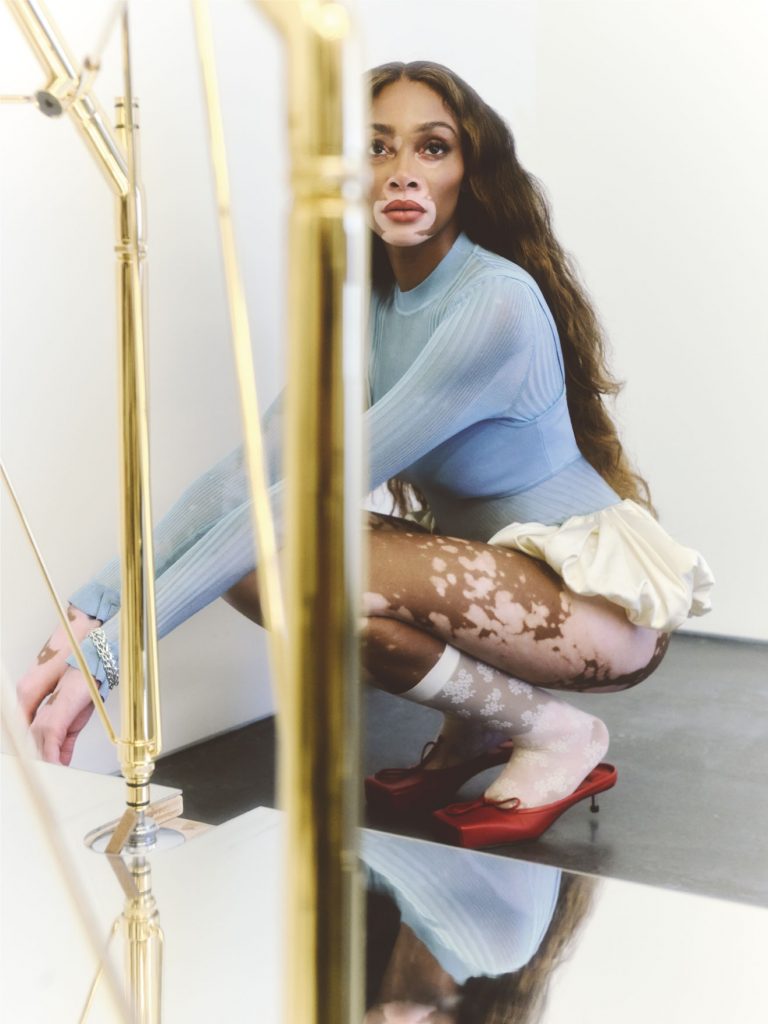 Carlos + Alyse
Carlos + AlyseTop (PH5), shorts (Jacquemus), socks (stylist's own), shoes (Jacquemus) and bracelets (Tiffany & Co.)
While she understands the fascination with her skin, her story is multi-faceted, and she refuses to be boxed in. “When it comes to my career, I feel like a lot of people want to talk about my skin, but there are so many other things in life that you deal with other than the one thing that you were bullied for in high school,” says Harlow. Her journey with her skin has been a source of strength—it also sparked the idea for her suncare line, Cay Skin. When she launched the brand in 2022 with just a few core SPF-forward products, including a face lotion, a lip balm and a body oil, she shared that a serious sunburn inspired her to venture into the suncare sphere. While on a shoot in the Caribbean in 2018, she was wary of reapplying sunscreen because she feared that its undesirable white cast would show up in the photos. Ultimately, the burn permanently altered the look of her vitiligo. Promising sheer sun coverage and a head-to-toe glow, Cay Skin’s selection has since expanded to include sun-safe and vegan essentials for the face, the lips and the body, all of which are enriched with ingredients inspired by Harlow’s Jamaican roots, from sea moss to aloe vera.
The line launched in an era when celebrities were creating skincare brands at breakneck speed. But Harlow’s experience gives Cay Skin a unique sense of purpose. Still, she’s aware of the critique. “I’ve seen people [say], ‘Oh, yeah, it’s a cash grab—she’s just trying to do something to make money,’” she says. “But I actually have a story when it comes to skin and SPF specifically. When I created Cay Skin, I wanted it to be something that was true to me.” When news of the line became public, Harlow was praised for joining a short list of women of colour who’d received over US$1 million of venture-capital funding. In total, she raised US$4.1 million to launch the brand. Before embarking on this journey, she admits, she didn’t even know what “VC” stands for. Today, Cay Skin is available at Sephora locations across the U.S. and Canada.
As Harlow mulls over my questions, her posture remains arrow-straight and her sheer white turtleneck stands out against the restaurant’s leafy green wallpaper, drawing attention upward to her hair. Though she has gone between sleek waist-length bussdowns, bronde waves, faux locs and occasional pops of colour over the years, she recently cut it into a pixie. It’s not her first big chop (she debuted a shorter ’do in 2016), but the introspection and intention behind her latest look are indicative of a major shift: Despite taking beauty standards to task over the course of her career, she has subconsciously upheld one for herself. “Getting older, I realized how much pride I had in my hair,” she reflects. When she revealed the style in August, it was curly and coiffed. Today, her cropped cut is sleek and straight with tiny curls flitting throughout to add dimension; it’s giving early-aughts, Die Another Day-era Halle Berry. “I wanted a fresh start. I’ve been short before but with wigs. I did like it, but I’ve always had a [desire] for long hair,” she explains. She tells me a story from her childhood, when she wrapped a towel around her head and pretended that it was her own hair, playfully making it flow in the wind. “Long hair has always been something that I held [up] as beauty.”
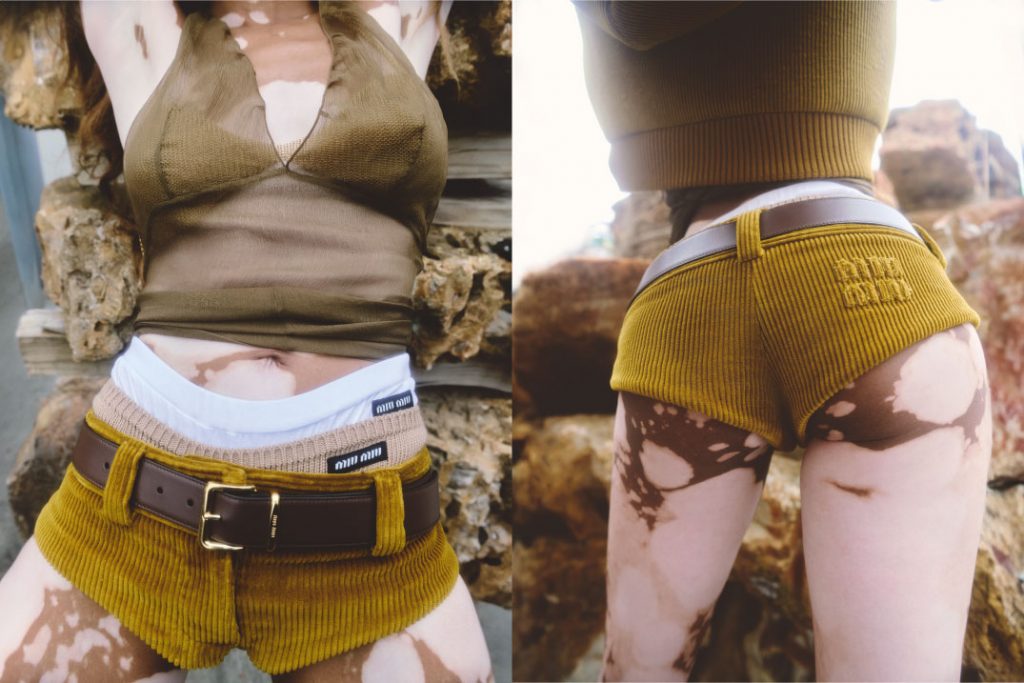 Carlos + Alyse
Carlos + AlyseTop, shorts, belt and briefs (Miu Miu) and chain-mail bra (Elsa Peretti at Tiffany & Co.)
It appears that part of accepting the responsibility of her mantle is viewing her relationship to beauty through a microscopic lens—and questioning her own perception of beauty. For Black women, in particular, this can have a more serious tenor. Historically, Black women have been inundated with messaging that suggests that they’re incapable of growing long hair or invalidates their curls if they grow outward in intricate coils versus cascading down their backs. Long hair can be an ideal that beckons to a more conventional, Eurocentric beauty standard. It’s not just hair.
For this reason, her cut was significant. “If I’m supposed to be this person who, like you said, is a beacon of confidence and I rely so heavily on something that I feel is part of the epitome of beauty, I need to be able to release that to truly feel beautiful. I don’t need long hair, even though from a young age it was something I loved.” Though she’s not opposed to occasionally switching it up with wigs (it was even her idea to sport a long style for our cover shoot), she realizes that hair can be something that’s interchangeable and can be switched up to enhance different looks. “When I’m wearing a certain outfit, I might want long black hair, or if I’m in Miami, I might want to be beachy, blond and curly or something. It’s a beautiful accessory, but it’s not necessary for beauty.”
As our conversation wraps, I learn that after our meeting, Harlow is off to get ready for an event with SKYY Vodka. As an ambassador for the brand, she’s in NYC for just 24 hours to celebrate the launch of its new espresso-infused spirit. “You should come,” she says earnestly. I initially dismiss the invitation as a pleasantry, but six hours later we are on the top floor of the Moxy hotel, sipping espresso martinis and swaying to “fukumean” by Gunna. Harlow has shed her off-duty-model style and is now in a hand-beaded PatBO denim ensemble. Glints of shimmering blue jewels on her bralette dance in the light as she poses for photo ops in front of the DJ booth and behind the bar, shaking cocktails.
“We should FaceTime my family,” she says. She calls her younger sister, Christina, then her mother, Lisa. As we regale them both with the tale of our meeting earlier that day, almost yelling over the music blaring from the Highlight Room, I hear someone on the line call her name: Chantelle. Her mother, says Harlow, alternates between “Winnie” and her given name. She now mostly goes by “Winnie” in her personal and professional life. “If I talk to someone close to me [frequently] enough, they call me Winnie,” she explains, “but if I haven’t spoken to someone in a long time, they call me Chantelle.” She answers to both but is more likely to answer to “Winnie” in a public setting. There are still distinctions between the two. “I feel like maybe my insecurities come from Chantelle and Winnie doesn’t have any.” She stipulates that they’re very much in sync and Winnie is not a persona but a nickname. “I’ve grown up and grown into Winnie—that is really who I am,” she says. “There’s a name for what I’ve done and [who I’ve] become.”
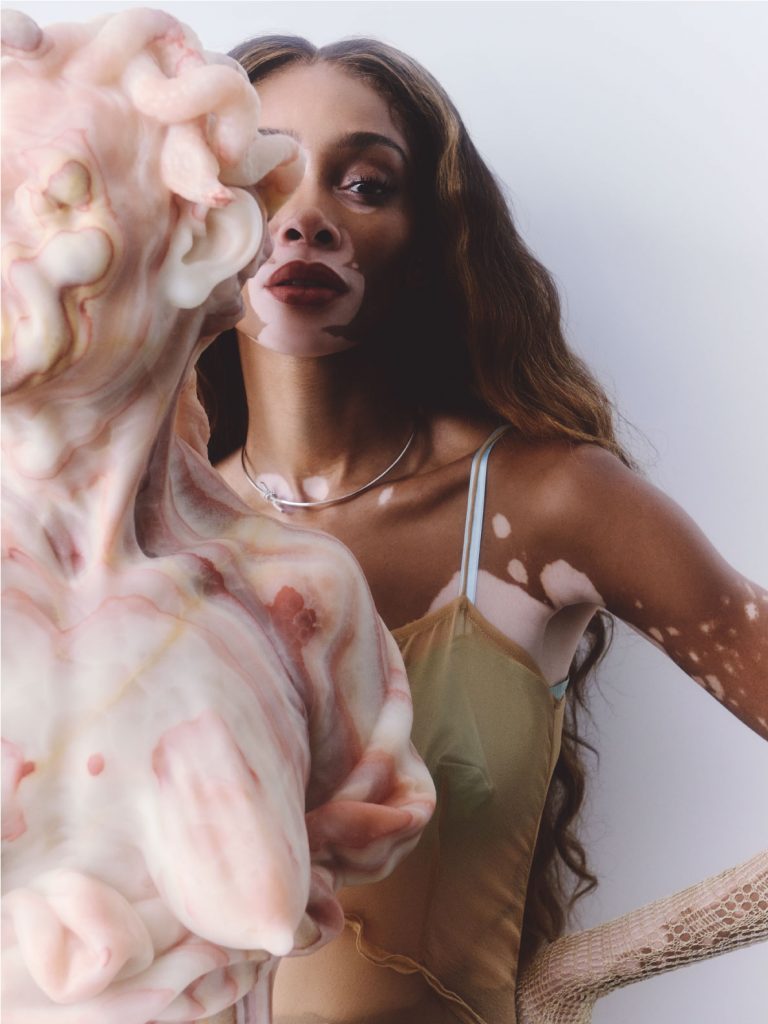 Carlos + Alyse
Carlos + AlyseEnvy (2008-2013) Bybarryxball sculpture, pakistani bellafi” onyx and stainless steel; Pedestal (58 X 44 X 24 CM), macedonian marble, stainless steel, wood, acrylic lacquer, steel, nylon and plastic. Dress (Kim Shui at Ssense), bra (Maison Margiela at Ssense), gloves (Isa Boulder at Ssense) and necklace (Tiffany& Co.)
As we part ways, she tells me that she’s heading back home to Los Angeles, where she moved mid-pandemic. Since relocating from New York to California, she’s been taking acting lessons in preparation for the next step she wants to take in her career. (She recently made a cameo in Netflix film The Perfect Find starring Gabrielle Union.) Back in 2020, she read for a role in a British zombie horror-comedy called The Loneliest Boy in the World and ultimately passed on it but has conflicting thoughts about how it went down. At the time, strict lockdown regulations would have required her to quarantine in the U.K. for two months. However, she had just begun a relationship with NBA star Kyle Kuzma and didn’t feel comfortable being away for such a long time. “I don’t know if I’m disappointed that I didn’t take it because I’m happy I didn’t at the time,” she tells me. The film was released in 2022, but she’s apprehensive about seeing it. “I’m going to watch it and think ‘I would have killed that,’” she says with a sigh.
I don’t get the impression that she spends too much time looking back, though. She has her sights set on the movie industry and is channelling her energy into what’s to come. While she no longer makes resolutions, she understands the power of setting intentions. Two years in a row, she wrote that she wanted to work with Beyoncé and then appeared in the music video for “Freedom” in 2016. “Even though it wasn’t something that I pursued—[Beyoncé] pursued me—it was still a manifestation and a prayer that I had put out into the world and to God.” For the year ahead, she’s focusing on Cay Skin and her new love: acting. “I am manifesting more growth and success with Cay Skin, and I’m manifesting working on a big film,” she tells me. But modelling will never be far behind. “I’ll make time for covers,” she says with a laugh. “Seeing myself on a cover always reminds me that there’s going to be a little girl who feels like I did and will look at that and feel seen. I wish I’d had that when I was younger.”
Find the full story in the Winter 2023 issue of ELLE Canada — out on newsstands and on Apple News+ October 23. You can also subscribe for the latest in fashion, beauty and culture.
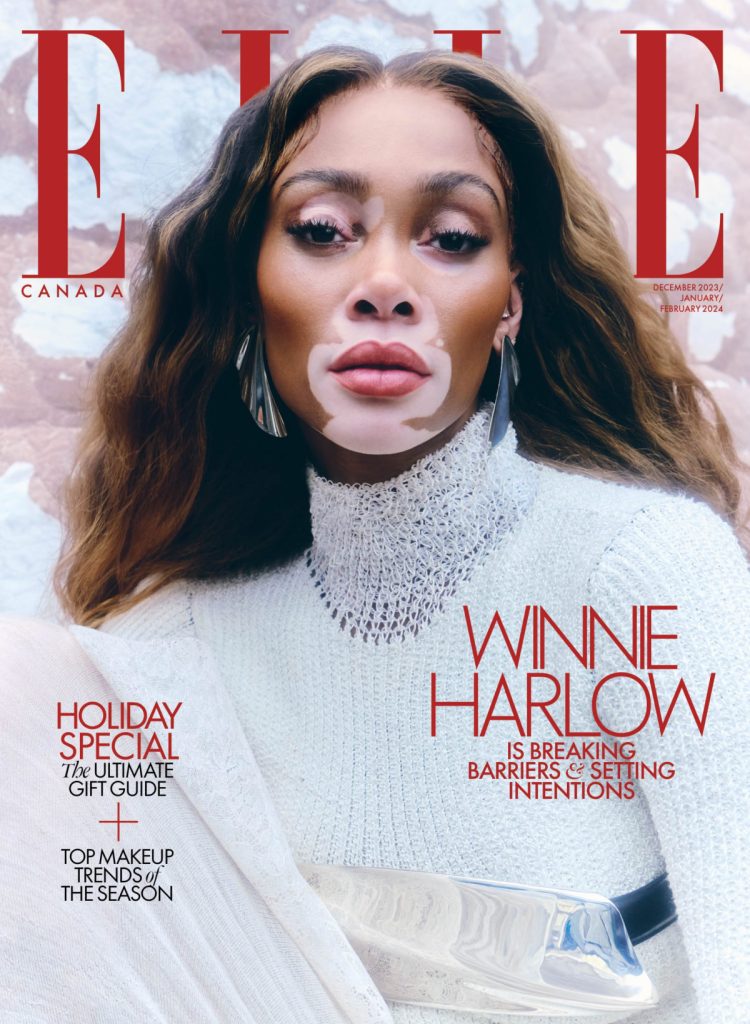 Carlos + Alyse
Carlos + AlyseWinnie Harlow is wearing a turtleneck and a lace skirt by Fendi, a bra top by St. Agni x Agmes, a dress by Lauren Manoogian and earrings by Tiffany & Co.
Publisher: Sophie Banford, Editor-in-chief: Joanna Fox,
Photographers: Carlos + Alyse, Creative director: Olivia Leblanc, Stylist: Jaclyn Bonavota (Cadre Artist Management), Makeup artist: Billie Gene (Opus Beauty), Hairstylist: Dhairius Thomas (Factory Downtown), Editorial producer: Pénélope Lemay, Set producer: Amaya Faria, Photographers’ assistants: Brandon Jones and Jeremiah Cumberbatch, Stylist’s assistant: Amer Macarambon
Thank you to Barry X Ball for giving us access to his studio and artwork.
Read more:
Winnie Harlow is ELLE Canada’s Winter 2023 Cover Star!
Winnie Harlow Knows the Value of Her Platform
Winnie Harlow’s Cay Skin Launches in Canada
Newsletter
Join our mailing list for the latest and biggest in fashion trends, beauty, culture and celebrity.
Read Next

Beauty
The Best Met Gala Beauty Looks Of All Time
From Taylor Swift's 'Bleachella' era to Rihanna's iconic 2011 braids, meet the best beauty moments in Met Gala history.
by : Katie Withington- Apr 26th, 2024

Culture
Benny Blanco Says He Fell in Love With Selena Gomez Without ‘Even Noticing’ It
Allow Benny Blanco to tell the straight-from-a-rom-com story of how he realized his feelings for his girlfriend and longtime friend.
by : Alyssa Bailey- Apr 26th, 2024
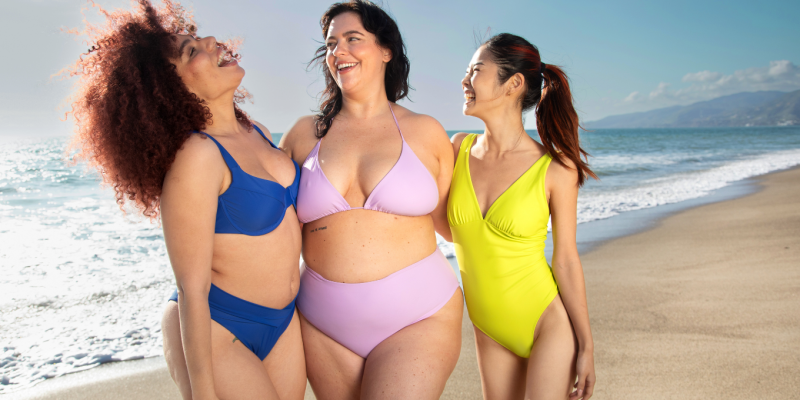
Beauty
Summer Prep: How to Feel Confident in Your Swimsuit
New Size-Inclusive Swimwear: Gillette Venus partners with The Saltwater Collective to Launch a Collection for Any Body
by : ELLE Canada- Apr 24th, 2024


